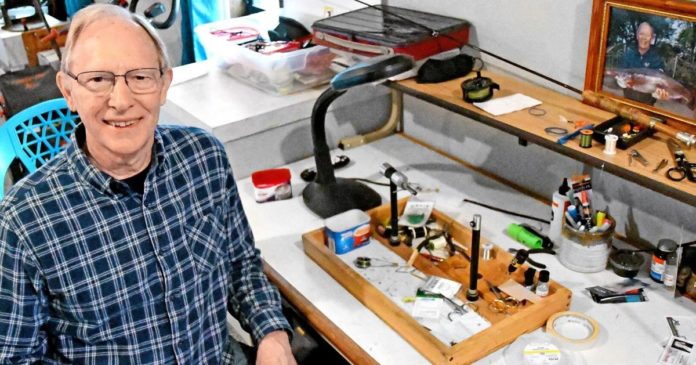SIOUX CENTER—Softly paddling a kayak and letting a stream of line leap forward with a quick flick of the wrist as he quietly searches for a waiting bass or sunfish: This is the image of a perfect day for Donald Mulder of Sioux Center.
The 73-year-old has been a lifelong angler, though in his youth, he didn’t have much opportunity to do so. The second oldest of 12 children, he was raised on his family’s farm near Primghar before they moved around a few times, eventually to California when he was 9.
He lived in Bellflower, a city with a Dutch dairymen heritage, and worked as a certified public accountant for 40 years. It was during his 50s that he got connected with a fly fishing club called the Downey Fly Fishers, named after a neighboring city. It was his introduction to fly fishing versus the kind of fishing he grew up with.
At first, he was lost; fascinated, but lost.
“They used a different language,” Mulder said, “but gradually I learned. They were very good to me. They loaned me their stuff, they showed me everything, they had their outings. So, then I learned.”
He got his start by fly fishing the ocean surf, which proved challenging.
“The learning curve is horrendously atrocious, unbelievably hard. But that’s where I cut my teeth, in the crashing surf,” Mulder said.
When he got the hang of it, he started teaching fly tying seminars for the fly fishing club. He even began to build his own fly fishing rods.
Donald Mulder of Sioux Center gives instructions on how to properly cast a fly rod during lessons at Prairie Woods Nature Center at Oak Grove Saturday.
“Fly fishing, it’s a nice way to fish. You don’t have to handle bait, which is very nice. And you don’t need to carry a lot of equipment. Maybe 90 percent of your fish will be lip hooked, very easy to take the hooks out. Then you’re right back in the game,” Mulder said. “And a fly rod is more fun to catch a fish on because you feel everything a lot better. You can feel if you snag a leaf.”
Fly fishing is also much more versatile than people sometimes think.
“People associate fly fishing with trout always, but that’s not true necessarily because any fish practically will take a fly. Very few that won’t take a fly. But fly fishing is a relative novelty here,” Mulder said. “So, I carry on the club theme where we want to pass this knowledge and skill down to the next generation. We’ve always focused on kids’ groups, trying to teach kids how to fly fish.”
When he retired, he and his wife, Kathy, decided to move back to the Midwest close to where he grew up, conveniently in the middle of where his four adult children moved. They came to Sioux Center in September 2020.
With the move came a change in the kinds of fish available to him, but fly fishing is still his go-to method, with his kayak providing him ready access to points of interest on the water.

Gary Vander Hart of Sioux Center practices his casting as Donald Mulder gives instructions at fly fishing lessons at Prairie Woods Nature Center at Oak Grove Saturday.
In these parts, he enjoys targeting bass and sunfish and kayaking at Lake Pahoja in Lyon County, the pond by Paullina, Sandy Hollow Recreation Area by Sioux Center, the Bruce Shomaker Recreation Area by Boyden, Pouders Pond adjacent Fairview, SD, and the Big Sioux Recreation Area by Hawarden.
Part of the appeal in fishing for him is that nothing is guaranteed, and when something does bite, it’s a fun fight.
“It’s gratifying to catch fish on a rod that you built yourself on a fly that you tied yourself,” he said. “That’s part of the allure of it. It’s always a bit of a challenge; are they going to be biting today?”
There can be a lot to keep track of, he’s learned. Barometric pressure and other weather conditions can make fish turn fickle or look for a feast.
With all the details that can factor into the odds of hooking into something, it’s easy to get distracted, but Mulder keeps to a simple fishing motto: “The best time to go fishing is when you have time to go,” he said with a laugh.
Fishing is also part exploration, learning about the environment he’s in. When learning the ropes on the ocean surf, how the waves break can hint at hidden structures that might be hiding fish.
“Each body of water,” Mulder said, “has to be learned.”
Credit: Source link































